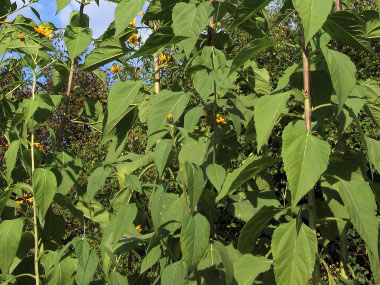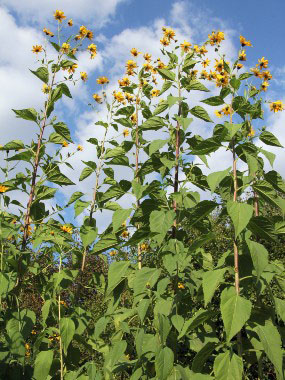








To support our efforts please browse our store (books with health benefits, etc.).
Jerusalem artichoke is an herbaceous perennial plant in the Asteraceae (sunflower) family. Helianthus is derived from the Greek Helios, meaning sun, and anthos, meaning flower. The species name is from the Latin meaning tuberous. Native to the U.S. and Canada, the original native region is thought to be north from Canada to Georgia, and west to Arkansas and Tennessee. This plant has currently established itself throughout Canada and in all but five states. This plant is sought after for the rhizomes that end in large, reddish, oval tubers. Jerusalem artichoke is also cultivated for its edible tubers.
Distinguishing Features
This very tall plant has robust, hairy stems and a unique arrangement of leaves on the lower and upper portions of the stem. The stem often branches along the upper half of its length. When there are several plants growing together, they have a bushy appearance. Although not visible until dug up, rhizomes end in oval tubers that are fairly large, often up to 10 cm (4") long and 6 cm (2.3") in diameter.
Flowers
Showy yellow flower heads grow at the ends of the stems. Each flower head is approximately 5 cm (2") in diameter and has anywhere from 8 to 20 outer petals that enclose the dark yellow to brown disk florets. The corollas of the disk florets are about 6 mm (1/4") long and narrowly tubular in shape. At the base of each flower head, there are green bracts arranged in 2 to 3 overlapping series. Flowers bloom late summer into early autumn depending on location.
 Fields
of Nutrition has medicinal benefits and vitamin/mineral content of Jerusalem Artichoke.
Fields
of Nutrition has medicinal benefits and vitamin/mineral content of Jerusalem Artichoke.
Leaves
Leaves can grow opposite or alternate along the lower to middle stems of this plant. Alternate leaves occur along the upper stems. Jerusalem artichoke leaves have a dull green color and they have a rough sandpaper-like texture. They are lanceolate to ovate and can grow up to 22 cm (9") long and 10 cm (4") wide. Margins are serrate-dentate. The bases of leaf blades are wedge-shaped to rounded, while their tips are acute. Leaf petioles are 6 mm to 6.4 cm (1/4 to 2.5") long, becoming increasingly winged toward the leaf blades; they are light green and minutely stiff-hairy to pubescent. Leaf petioles become progressively shorter as they ascend along the stems.
Height
This herbaceous plant is 60 cm to 2.4 metres (2 to 8') tall. The stems are light green to reddish brown, cylindrical or slightly tapering, and hairy. The stem hairs are white and slightly stiff.
Habitat
Habitats include woodland borders, moist to mesic black soil prairies, moist areas along rivers, thickets, roadsides, and miscellaneous waste areas. It is usually more common in disturbed areas. Jerusalem artichoke prefers full or partial sunny areas. It does not tolerate deep shade or maritime exposure. Native to the U.S. and Canada, this plant has naturalized throughout Europe, Asia, Oceania, Argentina, Chile Uruguay, and parts of Africa.
Edible Parts
The tubers are the only edible part of this plant. They are rich in inulin, a starch which the body has great difficulty digesting unless cooked. Some people are not very tolerant of inulin; it tends to ferment in their guts and can cause quite severe gas. Jerusalem artichoke tubers are similar in texture to water chestnuts and have a nutty flavor. Tubers are a great source of iron, magnesium, potassium, and calcium. Also, they are high in fiber and low in carbohydrates. It is best to harvest tubers late autumn but preferably after at least one hard frost.
Other Name
Sunchoke, Sunroot.
Similar Plants
Winter Survival Food Handbook

PDF Plant Magazines
Types of Wild Food
Geographic Zones Seasons
Disclaimer
EdibleWildFood.com is informational in nature. While we strive to be 100% accurate, it is solely up to the reader to ensure proper plant identification. Some wild plants are poisonous or can have serious adverse health effects.
We are not health professionals, medical doctors, nor are we nutritionists. It is up to the reader to verify nutritional information and health benefits with qualified professionals for all edible plants listed in this web site. Please click here for more information.
Why Edible Wild Food?
- Food costs are rising
- Free, wild food is readily abundant
- Wild food adds nutrition to your diet
- Wild food can help treat various medical conditions





